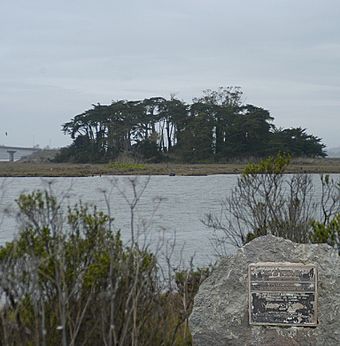Indian Island (Humboldt Bay) facts for kids
|
Gunther Island Site 67
|
|

National Register of Historic Places marker on Woodley Island in foreground, Indian Island on other side of channel.
|
|
| Location | Address restricted |
|---|---|
| Nearest city | Eureka, California |
| Area | 6 acres (24,000 m2) |
| NRHP reference No. | 66000208 |
Quick facts for kids Significant dates |
|
| Added to NRHP | October 15, 1966 |
| Designated NHL | July 19, 1964 |
Duluwat Island, also known as Indian Island, is a special place in Humboldt Bay near Eureka, California. It was once home to the village of Tolowot (or Tuluwat), where the Wiyot people lived. A very sad event, called the 1860 Wiyot Massacre, happened here. The island was also known as Gunther Island for many years. Today, a National Historic Landmark protects an important archaeological site on the island. Since 2019, the Wiyot people have owned most of Duluwat Island again.
Contents
Exploring Duluwat Island's Geography
Duluwat Island is the biggest of three islands in Humboldt Bay. It sits between the Samoa and Eureka Channels. The island is mostly made up of marshland that is affected by tides.
Over many centuries, the Wiyot people lived on the island. They changed its shape by building up large piles of shells. These piles, called middens, were left over from their fishing activities. These shell mounds made the island taller, so it could be seen from far away.
A Look at Duluwat Island's History
Early Life on the Island
The Wiyot people lived in Tolowot village on Duluwat Island for a very long time. Their daily lives, including eating shellfish, created huge shell mounds. These mounds made the island much higher than it was naturally.
In 1918, a researcher named Llewellyn Lemont Loud studied the island. He found evidence that people had lived there since about 900 CE. The tools and items he found helped experts understand early Native American cultures. These discoveries are known as the Gunther Pattern. They show how people lived and used tools in California until modern times.
The 1860 Massacre
On February 26, 1860, a terrible event occurred on Duluwat Island. About one hundred Wiyot people, mostly women and children, were killed. This happened during a special Wiyot ceremony. Settlers who had arrived in the area since 1850 were responsible for this act. Only a few people survived the massacre.
European Settlement and Changes
After the massacre in 1860, Robert Gunther bought the island. He gave it the name Gunther Island. For almost 40 years, Gunther built dikes and raised dairy cows there.
Later, in the 1870s, a shipyard was built on the island. This facility repaired ships and operated for over 100 years, closing in the 1980s.
Duluwat Island in Modern Times
In 1971, bridges were built across Humboldt Bay. These bridges, part of California State Route 255, connect Eureka to the peninsula. Two of these bridges have foundations on Indian Island.
Since 1992, the Wiyot people and their supporters gather on the island every year. They come on the last Saturday in February to remember those lost in the massacre. This gathering helps the community heal and grow stronger.
In June 2004, the city of Eureka, California, returned 67 acres (about 27 hectares) of land to the Wiyot people. This was a big step towards the Wiyot's goal. They hope to perform their World Renewal ceremony on the island again.
The city of Eureka and the Wiyot Tribe are working together. They have put in systems to stop the island's edges from wearing away. Before a new Wiyot dance facility can be built, pollution from the old shipyard needs to be cleaned up.
On December 5, 2018, the Eureka City Council voted to return the rest of the land to the Wiyot people. On October 21, 2019, the city officially gave all its land on the island back to the Wiyot. This means the Wiyot Tribe now owns most of Duluwat Island.
Images for kids
-
An aerial view of Humboldt Bay taken from the southwest. Tuluwat Island can be seen on the top left, next to Daby Island.




